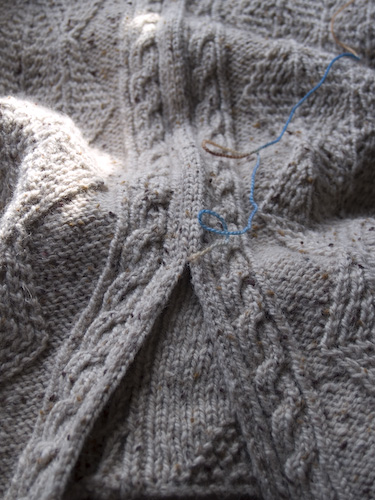noun
a pithy observation that contains a general truth, such as, “if it ain’t broke, don’t fix it.”
or, “don’t buy a zipper until you’ve cut your steek.”
But let’s begin with the steeking:

1) Weave a contrasting piece of waste yarn down the steek line to be darn sure it’s going in the right place.
2) Crochet a chain down either side of the stitch column to be cut.
3) Muster courage, and Ancient German Scissors; haply some Grandmamma Craft Juju doth linger in their blades.

4) Very. Carefully. Snip. And snip, and snip, and snip.

As you drag most of a worsted wool sweater all over town for months, it gets bulkier and bulkier. It fits into fewer and fewer of your knitting bags. Soon you’re lugging it about in one of the canvas grocery totes. It has grown so large and obstinate, so awkward to manipulate as you knit in the round, that it seems to have a certain indestructible life of its own. But when you vivisect it from stem to stern, how delicate the fabric feels! How vulnerable to the dangerous steel of the scissors!
At last, the steeking was done. I fired up the iron and dampened a dishtowel to steam the cut edges into submission. I pinned in the zipper. And this is where I should have stopped.

You sharp-eyed readers will already have stooped on the problem twitching in the tall grass: the 28″ zipper, which seemed so perfect pre-steeking, is no longer long enough. The darn front of the sweater GREW. Maybe it was the release of tension from the neighboring stitches after the cut. Maybe it was the steam ironing.

There’s a formula I need to learn:
when subject = craftsmanship and thought = “I can live with it”, action = force quit
Why did I think it wouldn’t be all that bad if the zipper was 3/4″ shy of the bottom and 1 1/2″ shy of the top? What possessed me to go ahead and hand sew half the cursed 28″ zipper in anyway?
This morning I came to my senses. I carefully measured the front against the back. Maybe the cut edge was just drooping and I could re-sew the 28″ zipper, carefully squinching the fabric back to its former shape along the way. The photo above makes it look like that’s the real problem, but it isn’t so. I needed a 30″ zipper.
Grumbling about Mr. Garter’s long torso, I drove all the way across town to the best place for zippers, the place I found the offending 28″ jobbie. I marched to the zipper section. Oh horrors. There were no brown 30″ zippers. The saleslady thought there probably never had been; it’s an unusual length and they mostly stock black or white ones. No, she didn’t advise buying the 36″ brown one and cutting it; this would only cause me grief with a molded-tooth dual separating zipper. I gnashed my own molded teeth. I thought about substituting an off-white color, but Mr. Garter had been so taken with the brown, and I’d bought a dark brown tweed yarn for the facing and neck lining to coordinate with it. I looked at all the options. I would have settled for a single-ended model, but they didn’t exist in the right length and color either. I even crawled in under the dangling zipper ends in the display to be certain no 30″ browns had fallen of their hooks and might be lying forgotten in the dark.
And just as I was about to admit defeat and drive home empty-handed, there it was, skulking behind some black zippers. 30″. Cloister brown. (This must be the dual separating sport zipper the Franciscan monks favor for their parkas.) It felt warm and pliable in my hand as I lovingly bore it to the cash register.
Mr. Garter’s Fishtrap Aran now has three zippers, hence today’s aphorism. Hopefully Goldilocks has got it just right this time. Now to unpick all my careful little stitches of last night. A six-year-old living a hundred years ago would have laughed at my slatternly basting job, I’m sure, but I was sewing the stitches as evenly and unobtrustively as I could and making sure they were sturdy enough to stand up to man-handling. The mens, they are not so gentle with the garments, after all. Ah well, I’m going to think of it as practice for the real zipper insertion, which will commence post haste.



















